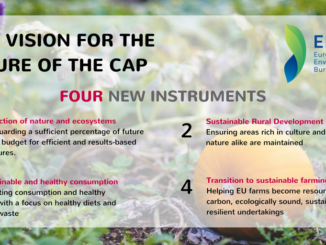New CAP Strategic Plans have been prepared and implemented since 2023 in all EU member states. Are they helping progress values of fairness, as enshrined in both CAP and other EU legislation? Here we summarise recent work by Henrik Maaß of German small farmer organisation ABL on this matter. While some progress and social innovation has been found, there is more stasis than change on display.
Is CAP fair?
Taking fairness as a starting point, there was much work to do to improve CAP’s fairness. Greater fairness means generational renewal and/or prioritising young farmers or new entrants; it means prioritising small farmers, producers on lower incomes and agri-food workers; improving the position of farmers in the agri-food system; equalising basic payments across the EU’s member states.
Wider EU policy and CAP objectives themselves – around generational renewal and fair incomes – reflect these needs.
For example the Treaty of Rome of the EU (article 39) points to the need to “ensure a fair standard of living for the agricultural community, in particular by increasing the individual
earnings of persons engaged in agriculture…In working out the common agricultural policy and the special methods for its application, account shall be taken of the particular nature of agricultural activity, which results from the social structure of agriculture and from structural and natural disparities between the various agricultural regions.”
And yet 6% of all beneficiaries received half of all direct payments. Moreover, although small farms received more direct payments per hectare than the EU average, the income per worker is particularly low in small farms compared to large ones.
According to a 2020 European Commission factsheet summary of the performance of CAP’s (then nine) objectives
“The income per worker is lower for smaller farms. Income per worker increases with farm size up to 500 hectare. The share of direct payments in the income per worker also increases with farm size up to farms with more than 75 hectares and then stabilises around 40%.” Income for small farms are too low for these farmers to be considered viable in most cases.”
There are tools in CAP to help fix this. These include Redistributive income support (CRISS) Income support for young farmers (CISYF), coupled income support, social conditionality and the Small Farmer Scheme.
Within CAP, capping ( placing a ceiling, or limit, on basic payments; degressivity – progressively lowering payments on larger units) the share of the overall budget CRISS receives, plus the upper limit for receiving CRISS, and the presence or otherwise of a small farmer scheme can be seen as indicators of fairness.
Supports for women farmers and degressivity within eco-schemes can also be seen as enhancing fairness; there are fewer women farmers and degreessivity is inherently redistributive, so applying it to ecological elements is also an indicator of fairness as these make up a proportion of all CAP payments.
(However, of the 44 result indicators in CAP only two explicitly cover fairness: R.6 redistribution to smaller farms; R.36 generational renewal. Both have a performance review).
How do the CAP Strategic Plans 2023 fare for fairness?
There are 28 CAP SPs (due to Belgian regions providing two). Of these 28, four – AT, BG, LI, LV – have implemented capping; two have implemented degressivity – PT, SI – While five have implemented a combination of of both: BE-Fl., BE-Wa., ES, IE, SK. This means 11 out of 28 CAP SPs have attempted to improve this most important and fundamental of fairness measures.
Taking this and other fairness variables into account, ABL estimates that there are only nine member states with R.6 above the EU average.
CRISS
Regarding CRISS, ABL points out that There are three ways in which the redistribution effect of this measure can be made stronger or weaker:
- Hectare range(s) “first hectare” definition
- Payment amount for first hectare (CRISS budget, degression)
- Upper farm size limit for reception of CRISS
Coupled redistributive income support for sustainability (CRISS, or “redistributive payments”), is granted as a top-up on the first hectares and is intended to serve as the main instrument for a fairer distribution of CAP funds.
Only five MS (CZ, HR, LI, BE-wa, HU) allocate significantly more budget to CRISS than the supposedly mandatory limit of 10%, while, by using exemptions, eight mange to stay below even this 10%. How it is possible to approve CAP SPs with these exemptions is questionable.
There is wide variability in definition of first hectares, in implementation steps, in exclusions of microfarms.
Small farmers scheme
For the small farmers scheme, under which farms can opt for a lump sum payment of up to E1250 annually per farm instead of making various bureaucratic applications, only five MS use (PT, BG, MT, LV, CZ) this.
The EU rule to limit this scheme at E1250 makes it unattractive for many member states to offer this measure, as the figure is so low. Even then, of the five who apply it, only Bulgaria applies the maximum amount – the others vary payments up to E1250.
Young farmers
Support for young farmers is possible both via direct payments as additional income support and via second-pillar measures such as support for business start-ups or a supplement to investment support.
Young farmer payments provide for a hectare-based premium in most member states, with three (Pl, BU and CY) granting an unlimited premium, but all others stipulating an upper limit of between 25 ha (GR) and 300 ha (HU). Only in the Czech Republic (SZ) is the upper limit below the average farm size.
Interestingly, three MS (LU, FR and NL) provide for a flat-rate farm payment instead of the area-based premium, which is paid annually for five years regardless of farm size.This ranges from E2800 (NL) per farm managed by a young farmer to E6660 (LU) In France, around E4600 was originally planned. However, due to oversubscription, the sum had to be reduced to less than E4000.
Women
As only 29% of farms in the EU are managed by women on average, some EU countries prioritise supports specific to women. Ireland pays women a 20% higher investment subsidy, while in Spain women receive 15% more income support for young farmers. In three MS (CZ, PT, IT) women have favourable selection criteria for business start-up support.
Integrating fairness and ecology
ABL argues that capping, degressivity and redistribution should not be limited to the basic income support, but should be applied in all CAP measures.
This would incentivise small farms to participate in eco-schemes, as their bureaucratic and operational costs are proportionally higher.
There are already some examples of this.
- A Polish Eco-scheme for animal welfare reduces payments per livestock unit by 25% between 100 and 150 livestock units, above which no payments are granted.
- Romania offers an Eco-scheme explicitly for small farms between 1-10 ha.
- In Wallonia and Flanders, payments for organic farming are degressive. Wallonia offers small organic vegetable farms a special premium of 4000 € per ha for the first three hectare for farms with a maximum of 10 ha. In Flanders, the Eco-scheme payments for precision farming and for a soil passport are also degressive.
- Spain initially provides for a reduction in large farms if the Eco-schemes are oversubscribed. One of the reasons given for this is to avoid overcompensation due to cost degression when implementing the Eco-schemes.
Of these considering wider societal needs and desires, the example from Belgium above on organic horticulture stand out as especially innovative.
Conclusion
For decades, those with very high incomes have received billions in taxpayers’ money from the CAP, which politicians have approved of. This is not only extremely anti-social, but also one of the real causes of the recent farmers protests.
These CAP SPs show some, but, limited, examples of fairness – but persistent issues remain. Convergence (of payments within member states and between member states) was supposed to be completed many years ago, and this CAP is doing the bare minimum in most cases to make this happen.
There are no examples of a majority of MS making progressive use of any fairness indicator in this analysis. A majority of MS – 17 – apply the lowest possible CRISS payments. Indeed some eight of these manage to avoid redistributive payments below what are supposed to be mandatory levels.
Only one MS (Bulgaria) applies the full small farmer payment; only one region (Wallonia in Belgium) applies a significant innovative payment for small-scale organic horticulture; only one (Ireland) applies a top up for women in farm business.
A much fairer distribution of all CAP funds (not just basic income support) is already possible within the current EU framework and is urgently needed. There are many existing mechanisms, but they are underused.
An efficient redistribution of direct payments is only possible with a mix of various measures and an effective design of the measures – and a genuine desire to make it possible and real.
 This article is produced in cooperation with the
This article is produced in cooperation with the
Heinrich Böll Stiftung European Union.
| Belgium | (BE) | Greece | (EL) | Lithuania | (LT) | Portugal | (PT) |
| Bulgaria | (BG) | Spain | (ES) | Luxembourg | (LU) | Romania | (RO) |
| Czechia | (CZ) | France | (FR) | Hungary | (HU) | Slovenia | (SI) |
| Denmark | (DK) | Croatia | (HR) | Malta | (MT) | Slovakia | (SK) |
| Germany | (DE) | Italy | (IT) | Netherlands | (NL) | Finland | (FI) |
| Estonia | (EE) | Cyprus | (CY) | Austria | (AT) | Sweden | (SE) |
| Ireland | (IE) | Latvia | (LV) | Poland | (PL) |
Many of the assets, as produced by ABL, which this article is based on, can be found here.
More
CAP not Matching Europe’s Green Ambitions, say Auditors (again)
Brussels News Roundup – Ombudsman Launches Inquiry into CAP Fast-Track
CAP Strategic Plans: A European Food and Agricultural Policy for Times of War
Re-CAP: Breaking down the breakdown of the EU’s green farming measures
Impact and Opportunities of the 2023-27 CAP Reform in Denmark
“CAP-as-you-wish Instead of Future-Proof Farming and Food Policy”
What the EU farmers survey tells us – and doesn’t tell us – about CAP burden







